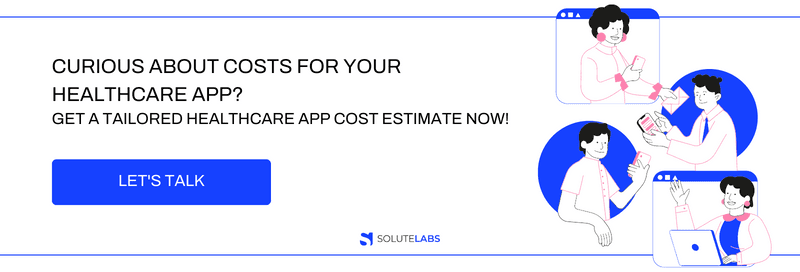Welcome to a world where health meets technology, where smartphones have become more than just gadgets – they're our health companions. If you've ever wondered how those healthcare apps come to life, you're in for a treat! Today, we're taking a peek behind the scenes to understand the magic of estimating costs for developing these amazing healthcare apps.
Imagine an app that lets you talk to a doctor, book appointments, or even track your heart rate – all in the palm of your hand. But here's the catch: turning these ideas into reality involves a lot more than just lines of code. From planning features to navigating rules and regulations, it's like solving a puzzle where every piece has a price. So, get ready to unravel the secrets of healthcare app development costs.
Factors Influencing Healthcare App Development Costs
The cost of healthcare app development is influenced by a multitude of factors that collectively shape the overall expense. Understanding these factors can help project managers, developers, and stakeholders make informed decisions and create accurate estimates. Let's delve into the details of these influential factors:
App Complexity and Features:
The complexity of the app is a major cost driver. Apps with simple functionalities like appointment scheduling will generally cost less than those with complex features like real-time health monitoring, telemedicine, integration with wearables, and AI-powered healthcare diagnostics. The more intricate and unique the features, the more development effort is required, translating into higher costs.
Design and User Experience (UX):
Creating an intuitive and visually appealing user interface enhances user engagement. A well-designed UX requires careful planning, wireframing, prototyping, and thorough testing. If the app demands intricate design elements, animations, or personalized user journeys, the health app design phase can contribute significantly to the overall cost.
Platforms and Devices:
Developing for multiple platforms (iOS, Android, web) increases development time and costs. Additionally, catering to various device sizes and resolutions, including smartphones, tablets, and wearables, demands extra effort for responsiveness and compatibility.
Integration with Third-party Systems:
Healthcare apps often need to integrate with electronic health records (EHR) systems, hospital databases, payment gateways, and other external services. These integrations can be complex, requiring careful planning, testing, and compliance with data security standards, which can contribute to the overall cost.
Data Security and Compliance:
Healthcare apps deal with sensitive patient data, necessitating compliance with strict regulations like HIPAA (Health Insurance Portability and Accountability Act). Ensuring data security, encryption, user consent mechanisms, and audit trails adds an additional layer of complexity and cost to the development process.
Regulatory Approval:
Depending on the app's purpose and the region it will be used in, obtaining regulatory approvals (e.g., FDA approval for medical devices) can be time-consuming and costly. Compliance with these regulations is crucial but can lead to extended development timelines and increased expenses.
Testing and Quality Assurance:
Given the critical nature of healthcare apps, rigorous testing and quality assurance are essential. Thorough testing across various devices, scenarios, and user behaviors ensures a smooth user experience and adherence to medical standards. This phase requires additional time and resources, contributing to the overall cost.
Maintenance and Updates:
Post-launch, maintaining and updating the app with bug fixes, feature enhancements, security updates, and platform compatibility adjustments is an ongoing expense. It's important to factor in long-term maintenance costs when estimating the total development cost.
Development Team Expertise and Location: The skill level and location of your development team impact the cost. Hiring experienced developers, UI/UX designers, and domain experts may incur higher expenses. Additionally, the geographic location of the development team affects labor costs, as rates vary between countries.
Project Management and Communication:
Efficient project management, regular communication, and collaboration among team members play a pivotal role in ensuring the project's success. Proper project management tools, regular meetings, and effective communication channels can increase costs if not managed effectively.
Cost Estimation by Healthcare App Types
Let's break down the cost estimation for different types of healthcare app development:
1. Telemedicine Applications:
Telemedicine apps facilitate remote consultations between patients and healthcare professionals. Cost factors include:
Features:
Basic telemedicine apps with video calling and appointment scheduling will cost less. Apps with additional features like prescription management, real-time health data sharing, and integration with wearable devices will increase costs.
Regulations:
Compliance with healthcare regulations like HIPAA significantly impacts costs due to data security requirements.
User Experience:
An intuitive and user-friendly interface is essential. Investing in a seamless user experience might increase design and development costs.
Integration:
Integrating with electronic health records (EHR) systems or third-party payment gateways could lead to higher costs.
Platform:
Developing for multiple platforms (iOS, Android, web) increases costs.
2. EHR/EMR Systems:
Electronic Health Record (EHR) or Electronic Medical Record (EMR) systems digitalize patient records. Cost factors include:
Customization:
Tailoring the EHR/EMR system to a specific healthcare organization's needs may increase development costs.
Features:
The complexity of features such as data entry, patient history, prescription management, and interoperability impacts costs.
Integration:
Integrating with other healthcare systems (e.g., laboratory information systems) adds to development expenses.
Security and Compliance:
Meeting industry regulations and ensuring data security drives up costs.
Scalability:
Building a system that can handle growing patient data over time adds to the budget.
3. Mental Health Apps:
Mental health apps offer tools for managing mental well-being. Cost factors include:
Features:
Basic apps with mood tracking and meditation features might have lower costs. Advanced apps with AI-driven therapy, personalized plans, and remote counseling will be more expensive.
Content Creation:
Developing quality mental health content – videos, articles, exercises – adds to costs.
Design and User Experience:
A calming and user-friendly design might require extra design efforts.
Regulations:
If the app offers therapy or treatment, adhering to mental health regulations impacts costs.
4. Remote Monitoring Apps:
Remote monitoring apps allow patients to track their health data from home. Cost factors include:
Devices Integration:
Integrating with wearables or medical devices (e.g., glucose monitors) impacts development costs.
Data Analytics:
Developing systems for collecting, analyzing, and presenting health data increases costs.
Real-time Alerts:
Creating features for sending alerts to patients and healthcare providers might add to development expenses.
5. Patient Portals:
Patient portals offer online access to medical records, appointment scheduling, and communication with healthcare providers. Cost factors include:
Features:
Basic portals might involve appointment scheduling and viewing medical records. Advanced portals with secure messaging, prescription requests, and payment integration are costlier.
User Authentication and Data Security:
Ensuring patient data security and privacy adds to development costs.
Customization:
Tailoring the portal's features to a specific healthcare provider's needs can increase expenses.
6. Hospital & Clinics Management Apps:
Apps for hospitals and clinics streamline operations. Cost factors include:
Modules:
Developing various modules for appointment scheduling, billing, patient management, and inventory control adds to costs.
Integration:
Integrating with existing hospital systems (e.g., EHR, laboratory) might increase expenses.
Scalability:
Building an app that can accommodate the growing needs of a healthcare facility adds to costs.
Regulations:
Compliance with healthcare regulations and standards can impact development efforts.
In all these cases, the complexity of the app's features, the need for integrations, the level of customization, compliance with healthcare regulations, user experience design, and the platform (iOS, Android, web) on which the app will run all contribute to the overall cost estimation. It's important to meticulously consider these factors to ensure accurate budgeting and successful execution of healthcare app development projects.
Also, Read: Digital Transformation in Healthcare Industry - Why & How?
Types of Cost Estimates
1. Ballpark Estimate:
A ballpark estimate provides a rough and preliminary cost projection based on limited information. It's often given in the early stages of project discussions to provide a general idea of what the project might cost. This type of estimate is based on high-level project specifications and is not intended to be highly accurate. It's useful for initial decision-making and gauging feasibility.
2. Detailed Estimate:
A detailed estimate is a more refined and accurate projection of project costs. It's developed after a comprehensive analysis of the project's scope, requirements, and intricacies. This estimate breaks down costs based on specific tasks, resources, and potential risks. Detailed estimates are typically used in later project stages and serve as the foundation for project budgeting and resource allocation.
3. Fixed Price vs. Time and Material Pricing Models:
Fixed Price Model:
In the Fixed Price model, the project cost is predetermined and agreed upon between the client and the development team before work begins. This model offers the advantage of predictability for the client, as they know the exact cost upfront. It also places the risk on the development team to deliver within the agreed budget. However, this model might not be suitable for projects with evolving requirements or uncertainties, as any changes or unexpected complexities could result in scope creep and additional charges.
Pros:
Predictability: Clients know the cost upfront, which helps with budgeting.
Less Client Involvement: Clients don't need to manage the development process actively.
Incentive for Efficiency: Developers have the motivation to complete the project efficiently to maximize their profit.
Cons:
Scope Limitation: Changes in project scope can lead to additional charges.
Less Flexibility: It's challenging to accommodate changes or new requirements without cost adjustments.
Time and Material Model:
The Time and Material model charges clients based on the actual time spent on development and the materials/resources used. It offers flexibility to accommodate changing requirements and allows clients to actively participate in project management. However, it requires active client involvement and can be less predictable in terms of final cost.
Pros:
Flexibility: Adapts well to evolving requirements and changing project scopes.
Client Control: Clients can actively manage the project and make adjustments as needed.
Transparency: Clients have a clear view of how time and resources are allocated.
Cons:
Cost Uncertainty: The final cost might not be known until the project is complete.
Client Involvement: Requires active engagement from clients in project management.
Risk of Mismanagement: Without proper control, costs can escalate.
Conclusion
To sum up, understanding the details of estimating healthcare app development costs shows us how complex this digital world can be. From new ways of talking to doctors online to making portals for patients, the mix of technology and healthcare is quite fascinating. With these ideas in mind, when you start making healthcare apps, you'll have a better idea of what things to think about. It doesn't matter if you're a tech person, a healthcare worker, or just really curious about all this – knowing about costs and how they fit with new ideas can guide you in making great healthcare apps for the future.
If you're ready to embark on your own healthcare app development journey and are seeking a trusted partner, look no further than SoluteLabs! Our expertise in healthcare app development ensures that your vision is transformed into a reality that's both functional and impactful. With a knack for creating user-centric experiences, adhering to regulatory standards, and delivering top-notch quality, SoluteLabs is your ideal companion in bringing your healthcare app dreams to life.
Explore our Healthcare App Development services and let us join you in crafting the future of healthcare, one app at a time. Reach out to us today and let's embark on a journey of innovation, care, and technology together. Your vision, our expertise – together, we can revolutionize healthcare app development!







